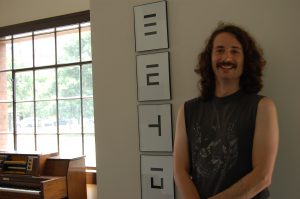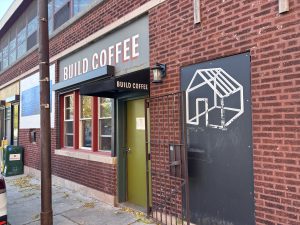Part I: Chicago street artist Blutt talks about his work and experiences living as a street artist in Chicago.
Blutt: The name I use for my artwork is Blutt. I live in Chicago and grew up around the Midwest and just kind of based on the stuff I grew up with like the music and skateboarding and graffiti and comic books. I do mostly nowadays stuff that is studio work paintings and drawings but I also have stickers and posters that I put up on the street. That stuff is mostly prints and reproductions that are pretty cheap and I can put them out there when I am out and about doing whatever. It seems to work pretty well when I can quickly throw stuff up and people see it and recognize it and tend to like it for the most part. Sometimes a few people tear it down but I like that too.
When did you decide to start creating street art?
Blutt: I kind of made a concerted effort to do that probably about the year 2000 is when I started doing wheat pastes and stickers. Back then it was more about hand drawn stickers because I never wanted to fork out the money to get it printed, which I like doing but it is so time consuming to do a little sticker and then put it up there and then it is gone. But prior to that it was always kind of doodling on stuff even in middle school it wasn’t even graffiti but just scribbling on stuff on lockers or street signs and stuff. Going skateboarding was always part of that culture, tagging stuff. I didn’t have a graffiti name or anything but I drew little characters and stuff on curbs and light posts. But it wasn’t until 2000 when I started going out at night purposefully with the intent of it lasting a little bit and people being able to see it.
What about your professional career as an artist?
Blutt: There was a noticeable reaction to stuff where people started recognizing my work and then sometimes
people say they see stuff at rest stops. I think people tend to end up buying stuff to legitimize it. It is partly
because I put stuff out but also because other people put stuff out and there is this burgeoning art movement.
But even if I don’t put stuff out on the street people buy it because they think it looks like graffiti. Once it
becomes a marketing effort it becomes work. I used to say yes all the time and then I would just get stressed out.
So I am trying to not do that and just do stuff for the sake of doing stuff and that is what I always liked about it
anyway – to blow off steam and not having to worry about if it fit for a specific project and meeting a deadline. It
ends up sucking the fun out of it. I have a job so I am not doing it for the money.
You are pretty open about what you do. Why did you decide to not take anonymity as serious as other
street artists?
Blutt: I don’t know it just seemed like a goofy kind of contrived game like I am the secret graffiti guy. You kind of
have to be to a certain point because you don’t want to get arrested but that is kind of part of the risk you take.
But after a while you meat enough people and it is like hey yeah that’s me and you know whatever your friends
know and you meet people and they recognize your stuff so then they ask you about it and they know. There
comes a point where it seems like you are forcing the anonymity on it rather than it being a necessity. I guess at
first you don’t want to make a big deal about it and just see how it goes. You almost make a bigger deal about it
than needs to be done with being anonymous. I don’t know what people want to be anonymous to after a while.
I mean after the police have your name what is the point? I was never worried about having a black mark on my
record because I never really had one so I am going to be cautious but I just try to keep it separate. They kind of
cross paths a little bit but I don’t go out of my way to hide it. I can understand where you are a global
phenomenon and you need to keep things relatively quiet. But that doesn’t really apply to my work.
What about the sticker community?
Blutt: Some people are really nerdy about collecting stickers. There is a billion and there are so many people
that I have never met. There are a couple of books out there of sticker art of handmade stuff and mass produced
stuff. It runs the gamut and it has become so broad. I do trade my stickers and when I get stickers from people I
divvy them up and then send them back out to other people who have sent me theirs instead of posting them in
my city. I like to send them back out in the world where they normally would not get. Flickr has sort of increased
the connectivity and sped up the process of seeing likeminded peoples’ stuff. I see my stickers up in Middle
Eastern countries and it just blows my mind. It is like in that Amelie movie where she sends the garden gnome
around. I just kind of scatter stuff out there and then other people scatter it too and then you just keep
perpetuating it.
Part II: Josh Lucas from thepodcollective arrives
Josh Lucas: My name is Josh Lucas and I run a website call thepodcollective. I cover graffiti and street art and
mostly want to share it and get it out into the world with not just an understanding of ‘everybody should be
paying attention to this’ but an understanding of why it exists and why people do it and what the benefits of
having this kind of art are. I actually think it is really important because you don’t have to go anywhere special to
see street art. It is for everybody.
What lead up to thepodcollective blog?
Josh Lucas: It stared a long time ago. I lived in a small town in Central Illinois that was built around a corn farm
and there is a train that runs through there and I used to go out there in junior high and take pictures of the trains
that would run through. When I moved to Chicago it was just all over the place and caught my eye more than
anything else. It took a few years to kind of think about it and then I started meeting people. This guy [Blutt] is
one of the first guys I met.
Blutt: And I am so inspiring that he has kept on keeping on!
Josh Lucas: I just started paying more attention. I got in touch with the Chicago flickr street art group and it just
kind of progressed from there. It is easier to do it here because that is what everyone wants to do in New York.
There is less competition and the need is still here. That is kind of why I started the blog because nobody
comprehensively covers this stuff. It has kind of changed and evolved a bit from what I was planning on doing. I
started out just posting pictures and then I started asking artist questions and adding artist profiles. Now I am
kind of just randomly writing. I want this whole world of art to get a little more attention. I am working on having
prints available on the site from artists. Some of them will be screen printed.
Are you working on any other related projects?
Josh Lucas: I was watching this dvd with my buddy called Burn to Shine. There is a whole series of them and I
think they originated in Portland. So they found a house that was about to be demolished and they contacted a
bunch of bands and recorded the performances in the house and at the end of the performance on the dvd you
watch the house get demolished. And I was thinking this would be a great project for street art. You could just
fill up the entire house with art and not have it open to the public but just document it and have a dvd and then it
would be demolished. And one reason I thought it would be great is because it is what street artists are used to
anyway, you put stuff up and then it disappears.
Blutt: I think Wooster Collective in New York they did something similar. But people from all over the world
came and produced work for this old factory and then people lined up to tour it. I am not sure if it was entirely
their idea but it was cool. It was that idea but on a grander scale. But that is almost too much for me at that point
to stand for hours and I think it would be kind of cool to do it on a small scale.
What makes the street art community in Chicago unique?
Josh Lucas: What really made me kind of realize how close the community is was when Solve was killed
about three years ago. The next two months there was stuff everywhere. You can blink and there was something
new up and it was all stuff by his friends putting his work or their work up. And it is nice to see a community that
is supportive of each other. So I was like well that is kind of what I look for when I want to involve myself into a
community. That is kind of why I kept going.



